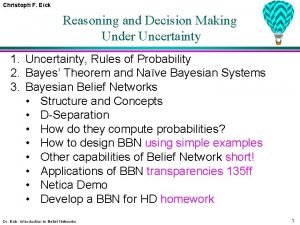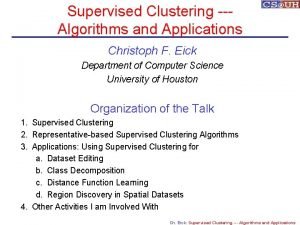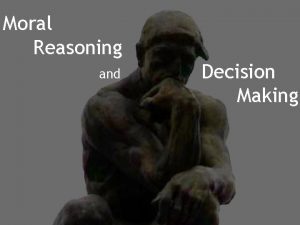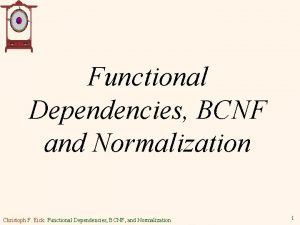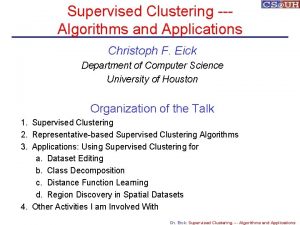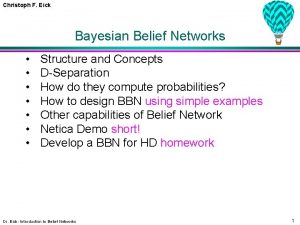Christoph F Eick Reasoning and Decision Making Under















- Slides: 15

Christoph F. Eick Reasoning and Decision Making Under Uncertainty 1. Uncertainty, Rules of Probability 2. Bayes’ Theorem and Naïve Bayesian Systems 3. Bayesian Belief Networks • Structure and Concepts • D-Separation • How do they compute probabilities? • How to design BBN using simple examples • Other capabilities of Belief Network short! • Applications of BBN transparencies 135 ff • Netica Demo • Develop a BBN for HD homework Dr. Eick: Introduction to Belief Networks 1

Christoph F. Eick Causes of not knowing things precisely Default Logic and Reasoning Uncertainty Incompleteness Belief Networks Vagueness Bayesian Technology Fuzzy Sets Dr. Eick: Introduction to Belief Networks 2

Christoph F. Eick Example 2 BN: probability of a variable only depends on its direct successors; e. g. P(b, e, a, ~j, m)= P(b)*P(e)*P(a|b, e)*P(~j|a)*P(m|a)=0. 01*0. 02*0. 95*0. 1*0. 7 3 Dr. Eick: Introduction to Belief Networks

Christoph F. Eick Basic Properties of Belief Networks Simplifying Assumption: Let X 1, …, Xn be the variables of a belief network and all variables have binary states: n 1. P(X 1, …, Xn)= P P(Xi|Parents(Xi)) “allows to compute all atomic events” i=1 2. P(X 1, …, Xp-1)= P(X 1, …, Xp-1, Xp) + P(X 1, …, Xp-1, ~Xp) 3. P(X|Y) = a* P(X, Y) where a =1/P(Y) Remark: These 3 equations are sufficient to compute any probability in a belief network; however, using this approach is highly inefficient; e. g. with n=20 computing P(X 1|X 2) would require the addition of 218+219 probabilities. Therefore, more efficient ways to compute probabilities are needed; e. g. if X 1 and X 2 are independent, only P(X 1) needs to be computed. Another way to speedup computations is using probabilities that are already known and do not need to be computed and taking advantage of the fact that probabilities add up to 1 Dr. Eick: Introduction to Belief Networks 4

Christoph F. Eick Fred Complains / John Complains Problem Assume that John and Fred are students taking courses together for which they receive a grade of A, B, or C. Moreover, sometimes Fred and John complain about their grades. Assume you have to model this information using a belief network that consists of the following variables: Grade-John: John’s grade for the course (short GJ, has states A, B, and C) Grade-Fred: John’s grade for the course (short GF, has states A, B, and C) Fred-Complains: Fred complains about his grade (short FC, has states true and false) John-Complains: John complains about his grade (short JC, has states true and false) If Fred gets an A in the course he never complains about the grade; if he gets a B he complains about the grade in 50% of the cases, if he gets a C he always complains about the grade. If Fred does not complain, then John does not complain. If John’s grade is A, he also does not complain. If, on the other hand, Fred complains and John’s grade is B or C, then John also complains. Moreover: P(GJ=A)=0. 1, P(GJ=B)=0. 8, P(GJ=C)=0. 1 and P(GF=A)=0. 2, P(GF=B)=0. 6, P(GF=C)=0. 2. 1. 2. Design the structure of a belief network including probability table that involves the above variables (if there are probabilities missing make up your own probabilities using common sense) Using your results from the previous step, compute P(GF=C|JC=true) by hand! Indicate every step that is used in your computations and justify transformation you apply when computing probabilities! Dr. Eick: Introduction to Belief Networks 5

Christoph F. Eick Example FC/JC Network Design GF GJ FC JC 1. 2. 3. 4. Specify Nodes and States Specify Links Determine Probability Tables Use Belief Network Nodes GF and GJ have states {A, B, C} Nodes FC and JC have states {true, false}; Notations: in the following, we use FC as a short notation for FC=true and Use ~FC as a short notation for FC=false; Similarly, we use JC as a short notation for JC=true and Use ~JC as a short notation for JC=false. We also write P(A, B) for P(A B). Dr. Eick: Introduction to Belief Networks 6

Christoph F. Eick Example FC/JC Network Design GF GJ FC JC 1. 2. 3. 4. Specify Nodes and States Specify Links Determine Probability Tables Use Belief Network Next probability tables have to be specified for each node in the network; for each value of a variable conditional probabilities have to be specified that depend on the variables of the parents of the node; for that above example these probabilities are: P(GF), P(GJ), P(FC|GF), P(JC|FC, GJ): 1. P(GJ=A)=0. 1, P(GJ=B)=0. 8, P(GJ=C)=0. 1 2. P(GF=A)=0. 2, P(GF=B)=0. 6, P(GF=C)=0. 2 3. P(FC|GF=A)=0, P(FC|GF=B)=0. 5, P(FC|GF=C)=1 4. P(JC|GJ=A, FC)=0, P(JC|GJ=A, ~FC)=0, P(JC|GJ=B, FC)=1, P(JC|GJ=B, ~FC)=0, P(JC|GJ=C, FC)=1, P(JC|GJ=C, ~FC)=0. Dr. Eick: Introduction to Belief Networks 7

Christoph F. Eick D-Separation l l Belief Networks abandon the simple independence assumptions of naïve Bayesian systems and replace them by a more complicated notion of independence called d-separation. Problem: Given evidence involving a set of variables E; when are two sets of variables X and Y of a belief network independent (dseparated)? Why is this question important? If X and Y are d-separated (given E) P(X&Y|E)=P(X|E)*P(Y|E) and P(X|E&Y)=P(X|E) D-separation is used a lot in belief network computations (see P(D|S 1, S 2) example to be discussed later); particularly to speed up belief network computations. Dr. Eick: Introduction to Belief Networks 8

Christoph F. Eick D-Separation : =All paths between members of X and Y must match one of the following 4 patters: X E(in E, not in E) Y (1 a) (1 b) (2) (3) Dr. Eick: Introduction to Belief Networks 9

Christoph F. Eick D-Separation A D C B E a) Which of the following statements are implied by the indicated network structure; answer yes and no; and give a brief reason for your answer! [6] i) P(A, B|C) = P(A|C)*P(B|C) yes, because… ii) P(C, E|D) = P(C|D)*P(E|D) no, because iii) P(C|A)=P(C) no, because Dr. Eick: Introduction to Belief Networks 10

Christoph F. Eick Fred/John Complains Problem 12 Assignment 3 Fall 2002 (1) (2) (3) (4) (5) P(FC)=P(FC|GF=A)*P(GF=A) + P(FC|GF=B)*P(GF=B) + (1) P(FC|GF=C)*P(GF=C) = 0*0. 2 + 0. 5 x 0. 6 + 1 x 0. 2 = 0. 5 P(JC)= … (problem description) = P(FC, GJ=B) + (FC, GJ=C) = (dseparation of FC and GJ) = P(FC)*0. 8 + P(FC)*0. 1=P(FC)*0. 9=0. 45 P(JC|FC)= P(JC, GJ=A|FC) + P(JC, GJ=B|FC) + P(JC, GJ=A|FC) = P(GJ=A|FC)*P(JC|GJ=A, FC) + … = (GJ and FC are d-separated) = P(GJ=A)*P(JC|GJ=A, FC) + P(GJ=B)*P(JC|GJ=B, FC) + P(GJ=A)* P(JC|GJ=A, FC) = 0. 1*0 + 0. 8 x 1 + 0. 1 x 1 = 0. 9 P(JC|GF=C)= P(JC, FC|GF=C) + P(JC, ~FC|GF=C) = P(FC|GF=C)*P(JC|FC, GF=C) + P(~FC|GF=C)*P(JC|~FC, GF=C) = (given FC: JC and GF are d-separated) = P(FC|GF=C)*P(JC|FC) + (3) P(~FC)GF=C)*P(JC|~FC) = 1*(JC|FC) + 0= 0. 9 P(GF=C|JC)= (Bayes’ Theorem) = P(JC|GF=C)* P(GF=C) / P(JC) = (4) (2) 0. 9*0. 2/0. 45=0. 4 Remark: In the example P(GF=B) and P(GF=B|JC) are both 0. 6, but P(GF=C) is 0. 2 whereas P(GF=C|JC)=0. 4 Dr. Eick: Introduction to Belief Networks 11

Christoph F. Eick Compute P(D|S 1, S 2)!! S 1 B l l l D S 2 All 3 variables of B have binary states: {T, F} P(D) is a short notation for P(D=T) and P(S 2|~D) is a short notation for P(S 2=T|D=F). B’s probability tables contain: P(D)=0. 1, P(S 1|D)=0. 95, P(S 2|D)=0. 8, P(S 1|~D)=0. 2, P(S 2|~D)=0. 2 Task: Compute P(D|S 1, S 2) Dr. Eick: Introduction to Belief Networks 12

Christoph F. Eick Computing P(D|S 1, S 2) (1) P(D|S 1, S 2)=P(D)*P(S 1|D)*P(S 2|D)/P(S 1, S 2) because S 1|D indep S 2|D (2) (3) (4) (5) (6) (7) (8) P(~D|S 1, S 2)=P(~D)*P(S 1|~D)*P(S 2|~D)/P(S 1, S 2) S 1|D indep S 2|D (1+2) 1=(P(D)*P(S 1|D)*P(S 2|D) + P(~D)*P(S 1|~D)*P(S 2|~D))/P(S 1, S 2)= P(D)*P(S 1|D)*P(S 2|D) + P(~D)*P(S 1|~D)*P(S 2|~D)=g P(D|S 1, S 2)= a / a + b with a=P(D)*P(S 1|D)*P(S 2|D) and b =P(~D)*P(S 1|~D)*P(S 2|~D) For the example a=0. 1*0. 95*0. 8=0. 076 and b =0. 9*0. 2=0. 036 P(D|S 1, S 2)=0. 076/0. 112=0. 678 S 1 D S 2 Dr. Eick: Introduction to Belief Networks 13

Christoph F. Eick How do Belief Network Tools Perform These Computations? l Basic Problem: How to compute P(Variable|Evidence) efficiently? » The asked probability has to be transformed (using definitions and rules of probability, d-separation, …) into an equivalent expression that only involves known probabilities (this transformation can take many steps especially if the belief network contains many variables and “long paths” between the variables). » For a given expression a large number of transformation can be used (e. g. P(A, B, C)=…) » In general, the problem has been shown to be NP-hard l Popular algorithms to solve this problem include: Junction Trees (Netica), Loop Cutset, Cutset Conditioning, Stochastic Simulation, Clustering (Hugin), … Dr. Eick: Introduction to Belief Networks 14

Christoph F. Eick Other Capabilities of Belief Network Tools l l l Learning belief networks from empirical data Support for continuous variables Support to map continuous variables into nominal variables Support for popular density functions Support for utility computations and decision support … (many other things) Dr. Eick: Introduction to Belief Networks 15
 Christoph eick
Christoph eick Christoph f eick
Christoph f eick Problem space in psychology
Problem space in psychology Decision-making under uncertainty
Decision-making under uncertainty Decision-making under uncertainty
Decision-making under uncertainty Non programmed decision example
Non programmed decision example No decision snap decision responsible decision
No decision snap decision responsible decision Financial decision
Financial decision Deductive vs inductive reasoning
Deductive vs inductive reasoning Deductive argument
Deductive argument Eick wilson
Eick wilson Nductive reasoning
Nductive reasoning Deductive reasonign
Deductive reasonign No mayten tree is deciduous
No mayten tree is deciduous Inductive vs deductive geometry
Inductive vs deductive geometry Patterns and inductive reasoning
Patterns and inductive reasoning
